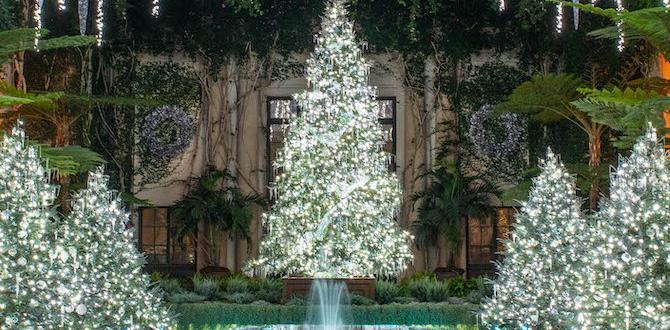When to turn on grow lights for indoor plants involves understanding your plants’ needs, their environment, and the type of light you’re using. Generally, turn them on when natural light is insufficient, typically during shorter winter days, in rooms with no windows, or for seedlings and specific flowering plants that require extended daylight hours. Proper timing ensures optimal growth and prevents plant stress.
Are you gazing out the window, wondering if your little green buddies are getting enough sun? It’s a common gardening puzzle, especially when the days get shorter or if your home doesn’t get much natural light. You might have a shiny new grow light and are eager to get it working, but the big question remains: when exactly do they need that extra boost? Don’t worry, figuring out the perfect time to switch on your grow lights is simpler than you think. We’re going to break it down, step-by-step, so you can give your plants the light they crave, exactly when they need it. Get ready to watch your indoor garden thrive!
The Essential Role of Light in Plant Growth
Light is more than just something that brightens our rooms; for plants, it’s their primary food source. Through a magical process called photosynthesis, plants use light energy to convert carbon dioxide and water into sugars, which they need to grow, bloom, and produce. Think of it like this: without enough sunlight, a plant is essentially trying to survive with an empty stomach.
This is especially true for houseplants, many of which originate from tropical environments with consistent, bright (but often filtered) light. When we bring them indoors, especially into less-than-ideal spots, their natural light cycle gets disrupted. This can lead to all sorts of problems, like leggy growth (long, weak stems with sparse leaves), pale foliage, and a complete halt in flowering or fruiting. Providing supplemental light isn’t about overfeeding; it’s about meeting their basic nutritional requirements in a way that mimics their native habitats.
Understanding this fundamental need for light helps us appreciate why timing the use of grow lights is so crucial. It’s not just about switching them on and hoping for the best; it’s about strategically supporting your plants’ life cycle and ensuring they get the energy they need to flourish. We want to create an environment that’s happy and healthy for our green companions, and light is the key ingredient.
How Much Light Do Plants Really Need?
This is where it gets interesting, and a little nuanced. Not all plants are created equal when it comes to their light appetites. Some plants, like succulents or cacti, are sun-worshippers and crave intense, direct light for many hours a day. Others, like many ferns or peace lilies, are content with lower light conditions, often found under the canopy of larger trees in their natural habitat.
The key to understanding plant light needs involves a few factors:
- Light Intensity: This refers to how strong or bright the light is. Think of the difference between standing in direct noon sun versus sitting in a shady spot under a tree.
- Light Duration (Photoperiod): This is simply how many hours of light a plant receives in a 24-hour period. Day-length matters!
- Light Spectrum: Plants use different colors (wavelengths) of light for different growth processes. Full-spectrum lights mimic natural sunlight and are generally best for overall growth.
Beginner gardeners often ask if they can just put any plant in any window. While some very adaptable plants might survive, most will fare much better when their specific light needs are met. For instance, a flowering plant like an orchid needs a certain number of hours of bright light to trigger blooming, while a leafy green like a pothos can tolerate lower light but will grow much lusher with more. Our goal is to bridge the gap between what nature provides and what our indoor environment can offer.
Signs Your Indoor Plants Need More Light
Your plants are pretty good communicators, if you know what to look for! They’ll often show you clear signs when they aren’t getting enough light. Being able to spot these tells is your first step to knowing when your grow lights need to come into play.
Common Indicators of Insufficient Light:
- Leggy Growth: This is perhaps the most common sign. You’ll notice that the stems are stretching out, becoming long and thin, with leaves spaced far apart. The plant is reaching desperately for a light source.
- Small, Pale Leaves: New leaves might be noticeably smaller than older ones, and their color might be a pale green or even yellowish. This indicates the plant isn’t producing enough chlorophyll due to a lack of light.
- Lack of Flowering or Fruiting: For flowering plants, insufficient light is a primary reason they won’t produce blooms. They simply don’t have the energy reserves to invest in reproduction. The same applies to plants grown for fruit, like chili peppers or small tomatoes.
- Leaning Towards the Light Source: If your plant is noticeably tilting or bending towards a window or your grow light, it’s a clear signal it’s seeking more illumination.
- Slow or Stunted Growth: If your plant seems to be doing nothing, not putting out new leaves, or growing at a snail’s pace, light is often the missing ingredient.
- Loss of Variegation: Plants with striking patterns on their leaves, like variegated monstera or pothos, might start to lose their unique markings and produce solid green leaves when light levels are too low. The dark green areas are where chlorophyll is concentrated, so the plant is trying to maximize its light-gathering capacity.
These signs are your plants’ way of saying, “Help! I need more light to be happy and healthy!” Once you recognize them, you can strategically deploy your grow lights to give them the boost they’re asking for.
When to Turn On Your Grow Lights: A Practical Guide
Now for the practical part! It’s not about constantly running your lights. It’s about intelligent use to supplement natural light. Here’s when and how to best utilize those grow lights:
1. Assessing Your Natural Light Situation
Before you even think about flicking a switch, take a good look at where your plants are located. Different windows offer different light intensities:
- North-facing windows: These offer the least direct light and are best for plants that prefer shade.
- East-facing windows: These get gentle morning sun, which is good for many plants, but can be insufficient during winter or for light-hungry varieties.
- West-facing windows: These receive hot afternoon sun, which can be too intense for some plants but good for others.
- South-facing windows: These typically offer the brightest, most consistent light, especially in the Northern Hemisphere (or North-facing in the Southern Hemisphere). This is ideal for sun-loving plants.
Consider the time of year. During winter, especially in higher latitudes, days are significantly shorter, and the sun’s angle is lower, meaning less intense light reaches your windows. Even a south-facing window might not provide enough light for certain plants from late fall through early spring. An easy way to check is to look at your plant during the day. If it’s not receiving direct or bright indirect light for at least 6-8 hours, it might benefit from grow lights.
2. Understanding Your Plant’s Specific Needs
As we’ve touched on, different plants have different light requirements. Grouping your plants by their needs can help you decide where and when to use your grow lights. A general categorization is:
- High Light Plants: These require 6+ hours of bright, direct, or very bright indirect light daily. Think of succulents, cacti, citrus trees, and many herbs (like basil, rosemary). If your brightest window isn’t providing this, especially in winter, grow lights are essential.
- Medium Light Plants: These need about 4-6 hours of bright indirect light per day. Many common houseplants like Monsteras, Philodendrons, and Fiddle Leaf Figs fall into this category. If your windows are shaded or you’re in a darker room, supplemental light is beneficial.
- Low Light Tolerant Plants: These can survive, but not necessarily thrive, in as little as 2-4 hours of indirect light. Snake plants, ZZ plants, and cast iron plants are examples. While they don’t need grow lights as much, providing them with a bit of supplemental light can encourage more vigorous growth and better color.
You can find reliable information on specific plant light needs from university extension websites, such as those from the Royal Horticultural Society (RHS) or local agricultural extensions.
3. When to Turn Them On: The Daily Schedule
The most common and effective use of grow lights is to supplement natural light during what would be the plant’s “daytime.”
- For supplementing window light: If your plant sits near a window that doesn’t get enough light, turn on the grow light during the hours when natural light is weak or absent. For example, if you have an east-facing window and know the morning sun isn’t enough, you might run the grow light from mid-morning until late afternoon.
- For plants in dark rooms: If your plants are in a room with no windows at all, your grow light becomes their primary light source. In this case, you’ll mimic a natural day cycle, usually providing 12-16 hours of light per day.
- Seed Starting and Seedlings: Young seedlings need ample, consistent light to prevent them from becoming weak and leggy. Turn on grow lights as soon as the seeds germinate and keep them on for 14-16 hours a day. The light should be positioned very close to the seedlings (follow manufacturer’s recommendations, usually just a few inches away) to provide maximum intensity.
- For Flowering and Fruiting: Many plants, especially those you want to bloom (like orchids or African violets) or fruit (like peppers or strawberries), require specific durations of light to trigger these processes. Some might need a longer ‘day’ period (e.g., 14-16 hours) to encourage flowering, while others may need a shorter ‘day’ period to induce blooming or fruiting. Research the specific photoperiod requirements for your fruiting or flowering plants.
A simple timer is your best friend here. It automates the process, ensuring your plants receive a consistent light schedule without you having to remember to turn them on and off. This consistency is vital for healthy growth.
4. How Long Should Grow Lights Stay On?
This is a crucial question that depends on your plants and your environment. There’s no single answer that fits all, but here are some general guidelines:
- Optimal Duration: Most common houseplants benefit from 12-16 hours of light per day. Full-spectrum LED grow lights are efficient, so running them for 12-16 hours is generally safe and effective.
- Seedlings: As mentioned, 14-16 hours daily is usually recommended for young seedlings.
- Flowering and Fruiting plants: This can vary greatly. Some plants need 8-12 hours to flower, while others need 14-18 hours. Research is key!
- Rest Period: Plants also need a dark period to perform essential metabolic functions. Running lights 24/7 is almost always detrimental. A dark period is as important as the light period.
For most general indoor gardening purposes, aiming for a 14-16 hour light cycle is a safe bet and will keep most plants happy. If you’re growing specific fruiting or flowering plants, delve into their individual needs.
Types of Grow Lights and Their Impact on Timing
The type of grow light you use also plays a role in its effectiveness and how you should employ it. Modern LED grow lights are incredibly efficient and versatile, but older technologies like fluorescent or incandescent bulbs behave differently.
LED Grow Lights
These are the most popular choice for home growers today due to their energy efficiency, long lifespan, and customizable spectrums.
- Full-Spectrum LEDs: These mimic natural sunlight and are excellent for all stages of plant growth. They are what we are generally referring to when discussing timing for general houseplants.
- White/Red/Blue spectrum LEDs: Some LEDs offer specific color blends. Red and blue light are critical for photosynthesis, while white light provides a broader spectrum for better plant appearance and overall health. For beginners, full-spectrum white LEDs are often the simplest to use.
When to use: Because they produce less heat and are highly efficient, LEDs can be positioned closer to plants without risk of burning, making them ideal for supplemental lighting in any situation. Their efficiency makes running them for 12-16 hours per day cost-effective.
Fluorescent Grow Lights (T5s, CFLs)
These have been a staple for a long time, especially for seedlings and leafy greens. T5 tubes offer good light intensity, while compact fluorescent lights (CFLs) are good for smaller areas or individual plants.
- Spectrum: Fluorescents come in various spectrums, such as “cool white” (more blue light, good for vegetative growth) and “warm white” (more red light, good for flowering).
- Heat: They produce less heat than incandescent, but more than LEDs.
When to use: Fluorescents are great for shelf systems or for starting seeds because they can be kept very close to the plants. Their timing should follow the 12-16 hour rule, especially for seedlings. Ensure adequate ventilation as they can still generate some heat.
Incandescent/Halogen Bulbs (Generally NOT Recommended)
While they produce light, incandescent and halogen bulbs are very inefficient for growing plants. They emit a lot of heat and not enough of the right light spectrum for healthy plant growth.
- Spectrum: Heavily skewed towards the red end of the spectrum, with very little blue light needed for vegetative growth.
- Heat: Produce significant heat, risking plant damage.
- Efficiency: Very low energy efficiency.
When to use: Honestly, it’s best to avoid these for plant lighting. If you must, they might contribute slightly to light in a very low-light situation, but they are not a primary grow light solution. Their heat output makes timed use tricky, as you risk cooking your plants if they are too close.
For most beginner indoor gardeners, a full-spectrum LED grow light on a timer is the easiest and most effective way to ensure your plants get consistent, quality light when they need it most.
Setting Up Your Grow Lights for Success
Getting your grow setup right is a bit like planting your seeds in the best soil. It sets the stage for everything to flourish. Here’s how to set up your lights for optimal plant growth:
1. Choosing the Right Location
Think about where your plants are positioned naturally. If they’re on a shelf near a window, you might suspend a light fixture above them. If they are on a desk, a desk lamp style grow light could work. For a collection of plants, consider a larger panel light or a light bar.
- Proximity to Existing Light: If supplementing, aim to place the grow light so it casts light onto the parts of the plant that are in shadow or would otherwise receive less light. Overlapping natural and artificial light can be very effective.
- Height Considerations: Ensure there’s enough clearance for the light fixture itself, plus any adjustments you might need to make as plants grow taller.
2. Adjusting Light Height
The distance between your grow light and your plants is critical. Too close, and you risk burning them (especially with older bulb types or lights that emit heat). Too far, and the light intensity reaching the leaves will be too low to be effective.
- LEDs: Most modern full-spectrum LEDs can be placed anywhere from 6 inches to 2 feet away, depending on the light’s power and the plant’s needs. Always check the manufacturer’s recommendations. As seedlings grow, you’ll need to raise the light.
- Fluorescents: These are typically placed 1-6 inches above the plants, offering good penetration for seedlings and smaller plants.
Tip: If you notice leaves getting scorched, bleached, or crispy, the light is too close or too intense. If plants are stretching excessively, the light is too far away.
3. Using a Timer
This is non-negotiable for consistent results. A simple plug-in timer is an affordable and effective way to manage your grow light schedule. Setting a reliable daily cycle helps plants regulate their growth and metabolic processes.
- Daily Cycle: Program the timer for your desired on/off times, aiming for 12-16 hours of light.
- Consistency is Key: Ensure the timer is reliably switching the light on and off each day.
For example, you might set your lights to come on at 7 AM and turn off at 9 PM to give your plants a 14-hour light cycle. If you’re supplementing, you could




